The Jurassic is a geologic period and stratigraphic system that spanned from the end of the Triassic Period 201.4 million years ago (Mya) to the beginning of the Cretaceous Period, approximately 145 Mya. The Jurassic constitutes the middle period of the Mesozoic Era and is named after the Jura Mountains, where limestone strata from the period were first identified.
The Triassic is a geologic period and system which spans 50.6 million years from the end of the Permian Period 251.9 million years ago (Mya), to the beginning of the Jurassic Period 201.36 Mya. The Triassic is the first and shortest period of the Mesozoic Era. Both the start and end of the period are marked by major extinction events. The Triassic Period is subdivided into three epochs: Early Triassic, Middle Triassic and Late Triassic.

Salvinia, a genus in the family Salviniaceae, is a floating fern named in honor of Anton Maria Salvini, a 17th-century Italian scientist. Watermoss is a common name for Salvinia. The genus was published in 1754 by Jean-François Séguier, in his description of the plants found round Verona, Plantae Veronenses Twelve species are recognized, at least three of which are believed to be hybrids, in part because their sporangia are found to be empty.
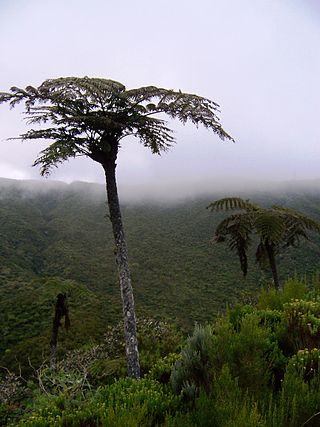
The Cyatheaceae are a family of ferns, the scaly tree ferns, one of eight families in the order Cyatheales in the Pteridophyte Phylogeny Group classification of 2016. Alternatively, the family may defined much more broadly as the only family in the Cyatheales, with the PPG I family treated as the subfamily Cyatheoideae. The narrower circumscription is used in this article.

Claytosmunda is a genus of fern. It has only one extant species, Claytosmunda claytoniana, the interrupted fern, native to Eastern Asia, Eastern United States, and Eastern Canada.

Hybodus is an extinct genus of hybodont, a group of shark-like elasmobranchs that lived from the Late Devonian to the end of the Cretaceous. Species closely related to the type species Hybodus reticulatus lived during the Early Jurassic epoch. Numerous species have been assigned to Hybodus spanning a large period of time, and it is currently considered a wastebasket taxon that is 'broadly polyphyletic' and requires reexamination. The first fossilized teeth from Hybodus were found in England around 1845; since then teeth have been recovered from Europe. During the Triassic, Jurassic, and Cretaceous periods, the hybodonts were especially successful and could be found in shallow seas around the world. For reasons that are not fully understood, the hybodonts became extinct near the end of the Late Cretaceous period.

Ceresiosaurus is an extinct aquatic genus of lariosaurine nothosaurid sauropterygian known from the Middle Triassic of Monte San Giorgio, southern Switzerland and northern Italy. Ceresiosaurus, meaning "Lizard of Ceresio". The type species, Ceresiosaurus calcagnii, was named by Bernhard Peyer in 1931. C. calcagnii is known from both the Cava superiore and Cava inferiore beds of the Lower Meride Limestone at Monte San Giorgio, dating to the latest Anisian of the Middle Triassic. Rieppel (1998) suggested that the back then monospecific genus Ceresiosaurus, is a junior synonym of the better known Lariosaurus, yet he kept it type species as a separate species under the new combination L. calcagnii. In 2004, however, this synonymy was objected by Hänni who described and name a second species of Ceresiosaurus, C. lanzi - a separation supported by several other authors since. This species is known only from the stratigraphically younger Cassima beds of Monte San Giorgio, although also from the Lower Meride Limestone, dating to possibly the lowest Ladinian age. The species in a subtropical lagoonal environment with varying open marine influences, and alongside many related but smaller species of nothosaurids and pachypleurosaurids. Ceresiosaurus represents one of the largest vertebrate of up to 3 m (9.8 ft) snout-tail length from the very diversified paleoenvironment of the Middle Triassic Monte San Giorgio.
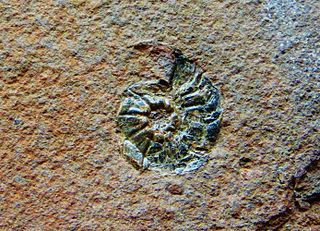
Asklepioceras is a genus in the Ceratitid family Arpaditidae from the Middle and Upper Triassic of Italy, Romania, Turkey, and British Columbia (Canada).

Palaeocoma is an extinct genus of brittle stars that lived during the Middle Triassic to Early Jurassic Periods. Its fossils have been found in Europe.

The forked ferns are the family Gleicheniaceae, which includes six genera and about 160 known species. The formerly independent families Dicranopteridaceae and Stromatopteridaceae are generally included in the Gleicheniaceae, whereas the Dipteridaceae and Matoniaceae, although closely related, are considered separate families by most authors.
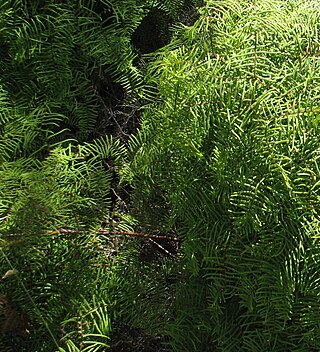
Gleichenia is a genus of ferns. Its closest relative is the genus Stromatopteris, restricted to New Caledonia.
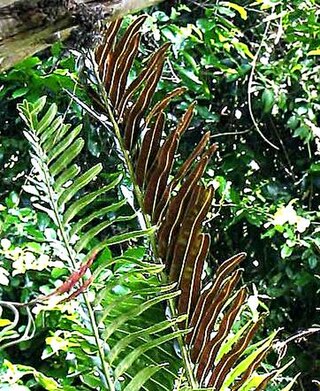
Acrostichum is a fern genus in the Parkerioideae subfamily of the Pteridaceae. It was one of the original pteridophyte genera delineated by Linnaeus. It was originally drawn very broadly, including all ferns that had sori apparently "acrostichoid", or distributed in a uniform mass across the back of the frond, rather than organized in discrete sori. This led Linnaeus to include such species as Asplenium platyneuron in the genus, because the specimen he received had sori so crowded that it appeared acrostichoid.

Saurichthyiformes is an extinct order of ray-finned fish which existed in Asia, Africa, Australia, Europe and North America, during the late Permian to early Middle Jurassic. Saurichthyiiformes comprise two families, Saurichthyidae and Yelangichthyidae. Whereas Yelangichthyidae is monotypic, Saurichthyidae includes at least two genera, Saurorhynchus and the very speciose Saurichthys. Additionally, the subgenera Costasaurichthys, Eosaurichthys, Lepidosaurichthys, and Sinosaurichthys are frequently used to group species. Saurichthyiforms were highly successful predators, and with Yelangichthys possibly even included durophagous forms. Species are known from both marine end freshwater deposits. They had their highest diversity during the Early and Middle Triassic.

Matoniaceae is one of the three families of ferns in the Gleicheniales order of the Polypodiopsida class. Fossil records reveal that Matoniaceae ferns were abundant during the Mesozoic era, during which they lived on every continent, including Antarctica, with eight genera and 26 species, with the oldest known specimens being from the Middle Triassic of Antarctica. Today the family is much less abundant, and also less diverse, with only two extant genera and four species, which are limited to portions of southeastern Asia.

Weichselia is an extinct genus of fern. They were abundant from the Middle Jurassic to Early Cretaceous. While generally supposed to have affinities to Matoniaceae, some research has suggested that they have closer affinites to the Marattiales, though its morphology is strongly divergent from both of these groups. They are thought to have grown similar to modern tree ferns, with an upright stem topped with a crown of fronds.
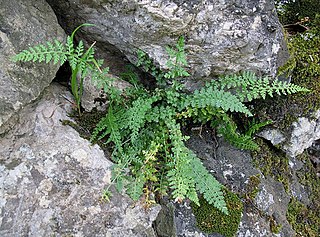
Asplenium fontanum, commonly known as fountain spleenwort or smooth rock spleenwort, is a species of fern in the family Aspleniaceae, native to rocky areas in Western Europe.

Phanerosorus is a genus of ferns in the family Matoniaceae.

Ctenis is a genus of fossil foliage attributable to the Cycadales, being one of the most common genera of cycad fossil leaves in the Mesozoic.

Coniopteris is an extinct genus of Mesozoic fern leaves. It was widespread over both hemispheres during the Jurassic and Early Cretaceous, with over 130 species having been described. While traditionally assumed to have been a member of Dicksoniaceae or a close relative of Thyrsopteris, a 2020 cladistic analysis found it to be a stem group of Polypodiales. Most species of Coniopteris probably had a herbaceous habit. Coniopteris laciniata had tufts of leaves sprouting from intervals of a thin, creeping rhizome. The genus is technically a junior synonym of the little used Polystichites, but was conserved by the ICZN in 2013. Some authors suggest a range of Early Jurassic-early Late Cretaceous for the genus, while others suggest a more expansive range spanning from the Middle Triassic to the Eocene.
Protorthophlebia is an extinct genus of scorpionflies, known from the Triassic and Jurassic periods of Eurasia. It was originally considered a member of the family Orthophlebiidae, but was later placed as the only genus within the family Protorthophlebiidae within the superfamily Panorpoidea.

















